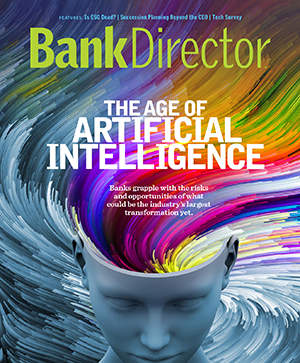K.C. Fike has worked in consultancy and data analytics since 2004. With his data and advanced analytics experience, he has led companies in developing analytic strategies. Assurance, tax, and consulting offered through Moss Adams LLP. ISO/IEC 27001 services offered by Moss Adams Certifications LLC. Wealth management offered through Moss Adams Wealth Advisors LLC.

Enhance Banking Risk Management With Artificial Intelligence
Banks can benefit from artificial intelligence by outlining a responsible implementation strategy, emphasizing ethical considerations and engaging in ongoing education.
Brought to you by Moss Adams LLP

As the financial landscape continues to evolve, the integration of artificial intelligence, or AI, will be essential for maintaining robust security and risk management practices.
By embracing AI-driven solutions and fostering a culture of innovation and education, financial institutions can enhance their resilience against cyberthreats and regulatory challenges. But sustained investment in technology and personnel training will be critical for bank executives and boards to unlock the full potential of AI.
AI encompasses both traditional and generative AI. Traditional AI follows predefined rules, while generative AI, a cutting-edge branch, is capable of creating new content by learning from existing data. It uses deep learning models, including large language models, or LLMs, to generate original outputs like text and images. Machine learning, a subset of AI, involves algorithms learning patterns from data to make predictions. AI can enhance predictive analytics, decision-making and security across various industries.
Using AI, banks can analyze vast amounts of data in real-time, identifying patterns and anomalies that might indicate potential risks. This makes AI a promising addition to risk management frameworks within the banking sector; traditional risk management strategies often rely on historical data and predefined rules, which can be insufficient in identifying novel or evolving threats.
Financial institutions can leverage AI to enhance their predictive analytics capabilities, enabling them to anticipate and mitigate risks before they materialize. Enterprise software they may already use increasingly incorporates AI-driven functionality, enhancing efficiency and decision-making. This integration enables advanced data analytics, predictive insights and automation in risk management software, significantly enhancing the identification of potential threats and improving overall risk mitigation strategies.
Banks can also use AI to keep up with the sophisticated tactics employed by modern cybercriminals that traditional fraud detection systems often struggle to detect and deter. AI continuously learns from new data and adapts its algorithms to detect emerging fraud patterns.
For example, AI can analyze transaction data in real time, identifying suspicious activities that deviate from typical user behavior. And by generating synthetic data, AI models can also simulate fraudulent transactions, helping to train detection systems to recognize and respond to new types of fraud. This dynamic approach enhances the accuracy and efficiency of fraud detection, reducing false positives and enabling faster response times.
Regulatory compliance, with stringent requirements designed to protect consumers and maintain the integrity of the financial system, is another critical concern for financial institutions. AI can play a pivotal role in helping banks maintain compliance by automating complex processes and providing deeper insights into regulatory risks. AI-powered tools can monitor transactions and communications, identify potential compliance deficiencies and generate alerts for further investigation. Additionally, AI can assist in developing compliance strategies by analyzing regulatory changes and predicting their impact on the institution’s operations. This proactive approach helps banks stay ahead of regulatory requirements, minimizing the risk of noncompliance and associated penalties.
Embracing AI Responsibly
For banking executives, the integration of AI presents both opportunities and challenges. To maximize the benefits of AI-driven solutions, boards should adopt a responsible implementation strategy that emphasizes ethical considerations and ongoing education.
- Identify AI opportunities: Financial institutions should analyze their processes and data to pinpoint where AI can be most beneficial through targeted and effective AI integration.
- Establish data governance: Develop clear policies for data privacy, quality, stewardship and access controls to ensure ethical and compliant use of AI.
- Promote continuous learning: Encourage ongoing education on AI and cybersecurity through regular training and workshops to keep staff updated and enhance risk management.
- Collaborate with partners: Work with industry partners, regulators and AI experts to gain insights and address emerging threats and regulatory challenges effectively.


